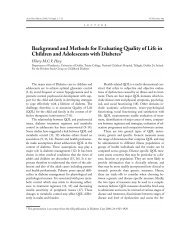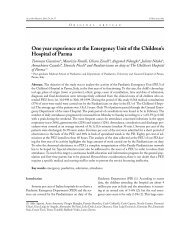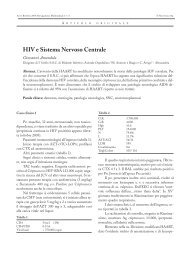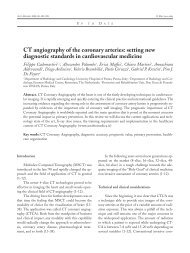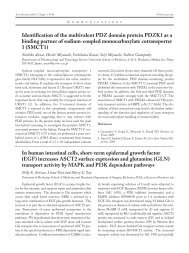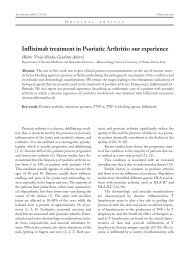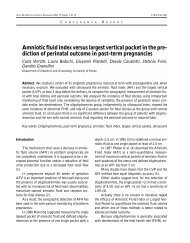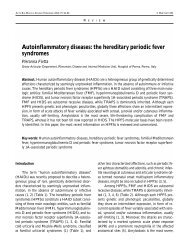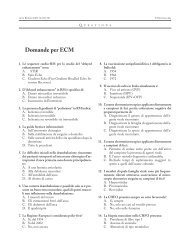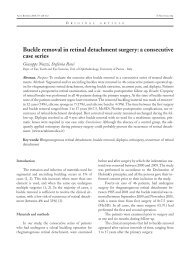cap. 1 cairella - Acta Bio Medica Atenei Parmensis
cap. 1 cairella - Acta Bio Medica Atenei Parmensis
cap. 1 cairella - Acta Bio Medica Atenei Parmensis
You also want an ePaper? Increase the reach of your titles
YUMPU automatically turns print PDFs into web optimized ePapers that Google loves.
ACTA BIOMED 2010; 81: 35-39 © Mattioli 1885O R I G I N A L A R T I C L EType 1 Diabetes (T1DM) in children and adolescents ofimmigrated families in Emilia-Romagna (Italy)Patrizia Banin 1 , Fiorenza Rimondi 1 , Aldo De Togni 2 , Stefano Cantoni 3 , Giovanni Chiari 4 ,Lorenzo Iughetti 5 , Silvana Salardi 6 , Stefano Zucchini 6 , Alberto Marsciani 7 , Tosca Suprani 8 ,Luis Tarchini 9 , Anna Tozzola 10 , Rossella Xella 11 , Maria Marsella 1 , Vincenzo De Sanctis 11Paediatric and Adolescent Unit, Department of Growth and Reproduction, Sant’Anna Hospital of Ferrara, Ferrara, Italy;2Epidemiology Unit; Azienda Unità Sanitaria Locale; Ferrara; Italy; 3 Paediatric Unit ,Hospital of Reggio Emilia, ReggioEmilia, Italy; 4 Department of Paediatrics University of Parma, Parma, Italy; 5 Department of Paediatrics, University of Modenaand Reggio-Emilia, Modena, Italy; 6 Department of Paediatrics, University of Bologna, Bologna, Italy; 7 Paediatric Unit,Hospital of Rimini, Italy; 8 Paediatric Unit, Hospital of Cesena, Italy; 9 Paediatric Unit, Ravenna Hospital, Italy; 10 PaediatricUnit, Hospital of Imola, Italy; 11 Paediatric Unit, Hospital of Forlì, ItalyAbstract. Background and aim of the work: The etiology and natural history of T1DM are still unknown butcertainly both genetics and environmental factors contribute to the development of the disease. Migrationstudies are an important tool to better understand the role of the environment. The aim of this study was toinvestigate some variables in diabetic children of immigrant families living in Emilia-Romagna comparedwith Italian diabetic children living in the same region. Methods: We recruited 73 diabetic children from immigrantfamilies and 707 Italian diabetic children. All children were cared by Pediatric Diabetes Units ofEmilia-Romagna (10 centers). The investigated variables were: gender, current age, place of birth, parents’country of origin, age at diagnosis, HbA1c and insulin regimen. Results: No significant difference with referenceto gender neither among the two ethnic groups, nor in the current mean age was observed. Mean ageat diagnosis in the Italian children was lower than in immigrant patients born outside Italy -group A- (7.4vs. 9.6, p
36 P. Banin, F. Rimondi, A. De Togni, et al.Table 1. Characteristics of Italian diabetic children and immigrant diabetic childrenItalian (91%) Immigrant (9%) pGender:M (%) 356 (50,6%) 34 (46,6%) n.s.F (%) 351 (49,4%) 39 (53,4%)Current mean age 13,3 13,4 n.s.(range) (1,5-23) (6,15-23)Mean age at diagnosis 7,4 7,8 n.s.(range) (0,8-17) (1-15,5):A) Born outside Italy (52%) p < 0,0009,6B) Born in Italy (48%) p < 0,0035,7A vs. Bp < 0,000Mean HbA1C % 8,2 8,8 p < 0,009(range) (4,7-14,3) (4,3-15,9)those with a genetic predisposition. Fewer than 10%of genetically susceptible subjects develop T1DM, arguingfor a modifying role of the environment in theinitiation or acceleration of islet autoimmunity. Thecontribution of the environment can also be gaugedon the basis of an observed concordance for disease ofonly 30-40% in identical twins (2). The causes are notyet completely understood, although various factorshave been proposed such as rapid growth in earlychildhood, early exposure to certain food constituents(e.g. cow’s milk hypothesis), enterovirus infection,chemicals and reduced exposure in early childhood toinfective agents that contribute to the development ofa healthy immune system (the “hygiene hypothesis”)(3, 4).During the last years we observed an increasedimmigration from developing countries to Europe. In2006 in Emilia-Romagna, one of the 20 regions ofItaly, as in the other European countries, the numberof immigrants was 6.9% of the total population, ofwhich 21.7% were children. At the same time we observedan increase in the number of diabetic childrenfrom immigrant families attending our Pediatric DiabetesUnits (Table 1).In the light of these considerations we decided tocarry out a diabetes migration study (5).Materials and methodsThe aim of this study was to investigate somevariables (sex, age, age at diagnosis, metabolic control)in diabetic children of immigrated families living inEmilia-Romagna compared with Italian diabetic childrenliving in the same region.We recruited 73 diabetic children from immigrantfamilies and 707 Italian diabetic children withDMT1. The diagnosis was done at least 1 year beforethe study (Figure 1). All children were cared by PediatricDiabetes Units of Emilia-Romagna (10 centers:Bologna, Ferrara, Modena, Reggio-Emilia, Parma,Forlì, Cesena, Ravenna, Rimini and Imola). We includedall immigrant children, who were adopted orliving with their parents and were born in Italy or inthe country of origin. Children were excluded whentheir immigrant parents came from a country ofWestern Europe (Austria, Belgium, Denmark, Finland,France, Germany, Iceland, Norway, Portugal,Spain, Sweden, Switzerland, the Netherlands and theUnited Kingdom), North America or Australia. Outof the immigrant families 49.3% came from NorthAfrica, 24.7% from East Europe, 13.7% from Asia,and the other ones from Sub-Saharan Africa (5.5%),South America (4.1%) and the Middle East (2.7%)
Type 1 Diabetes in immigrated children37(Figure 2). Out of the immigrant children 11% hadonly one immigrant parent (father or mother), 89%both.Data were collected through a questionnaire sentto all Paediatric Diabetes Units of Emilia-Romagnain December 2006. The variables investigated in diabeticimmigrant children and in diabetic Italian childrenwere: gender, current age, place of birth, parents’country of origin, age at diagnosis, glycated haemoglobin(HbA1c), and number of insulin injection perday. The characteristics of ethnic groups were describedusing proportions and means with range, andanalysed using χ 2 test or t-test two tails as appropriate;nonparametric data were analyzed by Mann-WhitneyU test. A p < 0.01 was accepted as statistically significant.A multiple linear analysis was used to test thecorrelations between glycated haemoglobin and ethnicgroup, age at diagnosis of diabetes and duration of disease.Analyses were performed using SPSS.The study was performed after informed consentof Diabetic Associations involved in survey and in accordanceto Helsinki Declaration (6).ResultsFigure 1. Total number and nationality distribution of diabeticchildren collected in our studyFigure 2. Origin nationality of diabetic immigrant childrencollected in our studyThe results are shown in Table 1. In the whole diabeticgroup 91% were Italian and 9% were immigrant.No significant difference with reference to genderneither among the two ethnic groups, nor in thecurrent mean age was observed.Out of the immigrant patients 52% were bornoutside Italy (group A) and 48% were born in Italy(group B).Mean age at diagnosis in Italian children was 7.4years (0.8-17), higher than in children of group B ( p
38 P. Banin, F. Rimondi, A. De Togni, et al.DiscussionThe younger age at diagnosis of T1DM in immigrantchildren born in Italy compared to Italian childrenand those born in developing countries is reportedby other authors (7). These findings suggest that environmentaldeterminants hasten the onset of type 1diabetes in immigrant children born in a more developedcountry like Italy. A younger age at diagnosis ofT1DM is generally considered as a marker suggestinga more aggressive impact of the environment on susceptibleindividuals (4). Furthermore other migrationstudies show an increasing incidence rate of T1DM afterimmigration (8, 9). This condition suggests the possiblepresence of environmental determinants due to amore westernized lifestyle, probably exercising theirsaction during pregnancy or first years of life in Italy.Some authors suggest that frequent infectious diseases,parasite infestation and intestinal biota in the countryof origin may be protective against T1DM (10, 11).Another important outcome of our study is thatthe immigrant children have significantly poorermetabolic control compared with Italian patients.Other authors found the same findings (12, 13). Havinga different ethnic background is often described asbeing a risk factor for poor metabolic control (14, 15),but whether the risk is represented by the ethnicity itselfor in combination with other factor remains unclear.According to some studies the risk factor for abad metabolic control is associated with a poorer qualityof life (13). Moreover, ethnic-minority parentsmore often report problems in their relationship withthe health care professionals and they have differentbeliefs about health and health care compared to native-bornparents. Mutual understanding and consequentlycompliance is often poor in consultations withethnic-minority parents than with native-born parents(16). Some Authors suggest that limited educationalbackground, insufficient skills regarding language, differentcultural health beliefs, as well as a frequentlymarginalized social position may represent seriousbarriers to achieve good metabolic control. Educationof immigrants with diabetes should be adjusted tomake allowances for limited schooling and professionaleducation in many families, and needs to includebasic knowledge of the religion, cultural backgroundand perceptions of health and sickness of individualpatients. Speaking a language in an intelligible waydoes not necessarily mean that a person is able to understandconcept such as anatomy and physiology, andprofessional interpreters should be used in diabeteseducation with these groups (12).ConclusionOur investigation confirms the findings alreadyreported in the literature:1. A younger age at diagnosis of T1DM in immigrantchildren, born in Italy compared withthose born in the country of origin, and withItalian patients, suggests the existence of someenvironmental determinants acquired with amore westernised lifestyle.2. Immigrant children show significantly poorermetabolic control compared with western patients.3. The metabolic control in immigrant patientswas worst compared to Italian diabetic childrenand was no related to the number of insulininjection per day. Therefore a strict patientsurveillance is needed associated to educationaldiabetic programmas.References1. 2007 International Diabetes Federation (IDF). Diabetes inchildren: epidemiology. Paediatric Diabetes 2007; 8 (Suppl.8): 10-8.2. Kumar D, Gemayel NS, Deapan D, et al. North Americantwins with type 1 diabetes. Genetic, etiological, and clinicalsignificance of disease concordance according to age, zygosity,and the interval after diagnosis of the first twin. Diabetes1993; 42: 1351-63.3. Couper JJ. Environmental triggers of type 1 diabetes. J PaediatricChild Health 2001; 37: 218-20.4. Gale EAM. The rise of childhood type 1 diabetes in the 20 thcentury. Diabetes 2002; 51: 3353-61.5. Servizio controllo di gestione e sistemi statistici RER 2006.6. World <strong>Medica</strong>l Organization. Declaration of Helsinki. British<strong>Medica</strong>l Journal 1996; 313 (7070): 1448-9.7. Cadario F, Vercellotti A, Trada M, et al. Younger age at diagnosisof type 1 diabetes mellitus in children of immigratedfamilies born in Italy. J Endocrinol Invest 2004; 27: 1-6.
Type 1 Diabetes in immigrated children398. Feltbower RG, Bodansky HJ, McKInney PA, Houghton J,Stephenson CR, Haig D. Trends in the incidence ofchildhood diabetes in south Asians and other children inBradford, U.K. Diabet Med 2002, 19: 162-6.9. Cohen MP, Stern E, Rusecki Y, Zeidler A. High prevalenceof diabetes in young adult Ethiopian immigrants toIsrael. Diabetes 1988; 37: 824-8.10. Kolb H, Elliott RB. Increasing incidence of IDDM a consequenceof improved hygiene? Diabetologia 1994; 37: 729.11. Gale EAM. A missing link in the hygiene hypothesis? Diabetologia2002; 45: 588-94.12. Povlsen L, Olsen B, Ladedund S. Diabetes in children andadolescents from ethnic minorities: barriers to education,treatment and good metabolic control. J Adv Nurs 2005, 50:576-82.13. Hoey H, Aanstoot HJ, Chiarelli F, et al. Good metaboliccontrol is associated with better quality of life in 2101 adolescentswith type 1 diabetes. Diabetes care 2001, 24: 1923-8.14. Delamatar AM, Shaw KH, Applegate EB et al. Risk formetabolic control problems in minority youth with diabetes.Diabetes Care 1999; 22: 700-5.15. Oversteet S, Holmes CS, Unlap WP, Frentz J. Sociodemographicrisk factor to disease control in children with diabetes.Diabet Med 1997; 14: 153-7.16. Joke CM, Wieringen V, Harmsen AM, Bruijnzeels MA.Intercultural communication in general practice. Eur J PublicHealth 2002; 12: 63-8.Accepted: February 5th 2010Correspondence: Patrizia Banin, M.D.Paediatric and Adolescent UnitSt. Anna HospitalCorso Giovecca, 203 – 44100 Ferrara (Italy)Tel. +39-0532-236034Fax +39-0532-247107E-mail: p.banin@ospfe.it



